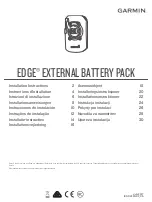
2
1-800-348-5004
Important Safety Instructions
1. Save these instructions. This manual contains important safety and operating
instructions for battery charger.
2. Do not expose charger to rain or snow.
3. Use of an attachment not recommended or sold by the battery charger
r injury to persons.
4. To reduce risk of damage to electric plug and cord, pull by plug rather than cord
when disconnecting charger.
5. An extension cord should not be used unless absolutely necessary. Use of
lectric shock. If extension
cord must be used. Make sure:
a. That pins on plug of extension cord are the same number, size, and shape as
those of plug on charger.
b. That extension cord is properly wired and in good electrical condition.
c. That wire size is large enough for AC ampere rating of charger.
6. Do not operate this charger with a damaged cord or plug. Replace the cord or plug
immediately.
7. Do not operate charger if it has received a sharp blow, been dropped, or otherwise
when service or
repair is required. Incorrect reassembly may result in a ri
9. To reduce risk of electric shock, unplug charger from outlet before attempting any
maintenance or cleaning.
Recommended minimum AWG size
for extension cords for battery chargers
AC input rating, amperes*
AWG size of cord
Length of cord, feet
Equal to or
greater than
But less
than
25
50
100 150
0
2
18
18
18
16
2
3
18
18
16
14
3
4
18
18
16
14
4
5
18
18
14
12
5
6
18
16
14
12
6
8
18
16
12
10
8
10
18
14
12
10
10
12
16
14
10
8
12
14
16
12
10
8
14
16
16
12
10
8
16
18
14
12
8
8
18
20
14
12
8
6
Note:
If the input rating of a charger is given in watts
rather than in amperes, the corresponding ampere
rating is to be determined by dividing the wattage
rating by the voltage rating – for example:
1250 watts/125 volts = 10 amperes



























